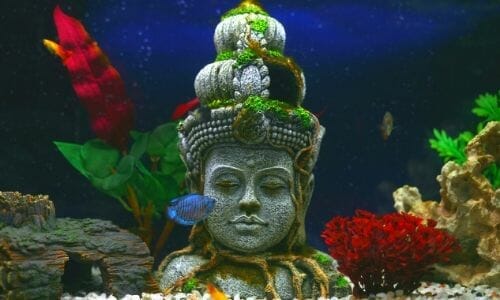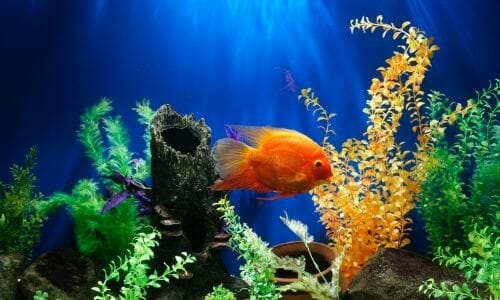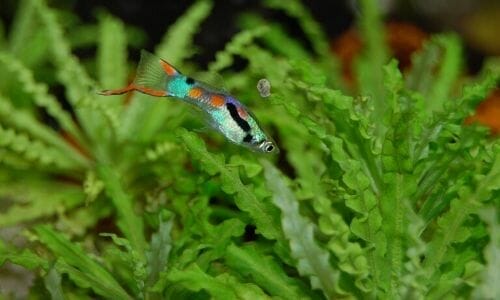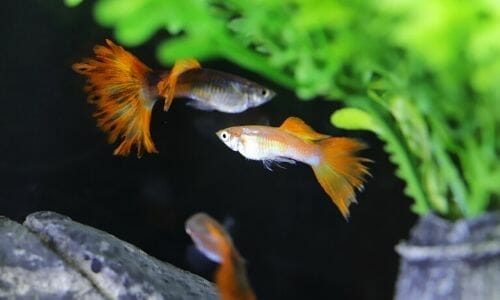You want to keep live plants in your aquarium. But you are concerned if they are hard to keep then you are in the right place.
In this article, I will tell you everything you need to know about live aquarium plants.
I will tell you:
How to keep live aquarium plants in your aquarium.
How to take care of them so that they can thrive in your tank.
I will share with you some beginner-friendly plants.
So let’s get into it.

Table of Contents
So, are aquarium plants hard to keep?
No, aquarium plants are not hard to keep. But you do have to provide them the ideal environment i.e. you have to maintain the ideal water parameters (temperature, pH, and hardness). And you have to provide them the ideal lighting conditions and regularly feed them fertilizers.
If you just do that, your aquarium plants will thrive in your aquarium.
Are Aquarium Plants Good? (Everything you need to know)
How to keep live aquarium plants in your aquarium?

The first step in the process of keeping live plants in your aquarium is choosing the live plants for your aquarium.
How to choose live plants for your aquarium?
Now, this is a very important step especially if you are going to keep live plants for the first time in your aquarium.
Easy and low maintenance plants
If you are a beginner then I highly encourage you to go for easy, hardy, and low maintenance aquarium plants.
I have created a massive list of 52 beginner-friendly live plants you can easily keep in your tank. You can check it out here.
With these plants, you will have a better chance of keeping them successfully in your tank and they will not die off in your tank.
These plants also don’t require any fancy equipments and additional carbon dioxide.
Water parameters
The second most important thing while choosing live plants for aquarium is water parameters.
Ideally, you should choose the plants that require similar water parameters that the fish in your aquarium requires so they can thrive in the same aquarium.
14 Best Fast Growing Aquarium Plants (without CO2)
Substrate
If you already have an aquarium, you should choose the live plants according to your substrate.
If you are starting with a new aquarium then you can choose a mineral-rich substrate that is specially made for or growing aquarium plants.
Honestly, most easy plants don’t require special substrate i.e. the substrate which is particularly made for aquarium plants.
You can easily grow hardy aquarium plants without any special substrate in the gravel or in the sand.
But you will need to feed them fertilizers in the form of root tabs if they are root feeder aquarium plants.
13 Best Aquarium Plants For Gravel Substrate
Light requirement
Plants require lighting to create their own food through the process of photosynthesis.
If the plants don’t get sufficient light then they will not survive for a long time in your tank.
For most plants, even the easy and hardy plant requires good lighting.
Though there are a few very hardy plants that can do just fine in any lighting conditions such as Java moss and Duckweed.
Usually, the lighting that comes with an aquarium kit is not sufficient or ideal for growing aquarium plants.
So while choosing aquarium plants for your tank, you should make sure to look into how much light does the plant requires and get the lighting setup accordingly.
Thankfully, nowadays there are some lighting setups that have the functionality to increase or reduce the intensity of light.
So you can easily increase or decrease the intensity of light according to your plants’ needs.
Also, there are some lighting setups that come with an inbuilt timer so the lights will turn on and off automatically.
You can also buy a timer separately.
You can check out my recommended lighting setup here.
Preparing live plants for planting in your aquarium

Once you choose live plants for your aquarium, before planting them in your tank, first of all, you have to clean them.
The thing is before you get live plants for your tank they are grown somewhere in the farm or in an aquarium.
So there is always a risk that the plants may carry harmful pests and transfer it in your tank.
That’s why it is very important to clean the plants before planting them in your tank.
There are two ways to clean aquarium plants.
1. Using a bleach solution
To clean the aquarium plants with a bleach solution, first of all, you should remove rubber bands from the plant.
Then take them out of the pot. And then soak them in a very dilute bleach solution (approximately one tablespoon bleach per gallon of water) for about 1 hour.
Then you should wash the plants in running tap water.
And then you should put the live plants in a bucket containing dechlorinated tap water overnight.
You can easily dechlorinate the tap water using a dechlorinating agent that you can buy from your nearest pet store or online.
2. Cleaning plants using a hydrogen peroxide solution
Cleaning the live plants using a hydrogen peroxide solution i.e. antiseptic solution is similar to cleaning the plant with the bleach solution.
You just have to replace the bleach solution with the hydrogen peroxide solution.
First of all, you should remove the rubber bands from the plant. And take them out of the pot.
Then put the live plants in hydrogen peroxide solution for about an hour.
Then you should clean the plant with running tap water.
And then you should put the live plants in a bucket containing dechlorinated tap water overnight.
Once you prepared or cleaned your aquarium plants then it is time to plant them in your aquarium.
11 Best Red Aquarium Plants (Beginner Friendly and Undemanding)
How to plant live aquarium plant in your tank?

Depending on the plant there are different ways to plant aquarium plants in the tank.
Basically, there are 4 different types of aquarium plants. And the method of planting them in the tank varies.
1. Rosette plants
Rosette plants are the plants that have a lot of roots at its bottom.
These plants have a very long and complex root structure.
You have to plant these plants in your substrate.
Before planting them in the substrate, you should cut down their long roots and keep only about 2 inches long roots. Doing so will encourage new root growth.
To plant Rosette plants in the substrate, just make a hole in the substrate with your finger. And then insert the root of the plant into the hole and cover their roots with the substrate.
8 Best Aquarium Plants for Sand Substrate (Easy to Care and Maintain)
2. Stem plants
Stem plants usually have their roots near their nodes.
That’s why you don’t have to plant them into the substrate.
You can simply tuck it into the substrate.
You can even tie it to any driftwood or rock in your tank and it will grow roots automatically.
8 Best Aquarium Plants That Grow On Driftwood and Rock
3. Rhizome plants
Rhizome plants, as the name suggests, have rhizomes instead of roots.
These plants don’t get nutrients through their rhizomes but through their leaves.
You don’t have to plant them into the substrate.
You can tie them or glue them to any ornament in your tank like driftwood or rock.
13 Best Aquarium Plants That Can Grow Without Substrate
4. Floating plants
Floating plants, as the name suggests, are floating aquarium plants.
These plants don’t require any substrate to keep in the tank.
They usually float on the surface of the water of your tank and their roots stay hanging down.
These plants provide good shelter to fish fry. They also help to reduce temperature and light in the tank.
15 Ways to Lower Temperature in an Aquarium
How to take care of live aquarium plants in an aquarium (for beginners)

Now I will share with you some basic aquarium plants care tips with you.
Light
Lighting is one of the most important factors when it comes to the proper and healthy growth of your aquarium plants.
Plants prepare their own food using light by photosynthesis.
Light also helps plants to absorb carbon dioxide.
Besides, plants look beautiful under good lighting.
So for the proper growth of aquarium plants, you should provide it the ideal lighting that the plant requires.
22 Best Live Tall-Growing Aquarium Plants
Fertilizers
Plants require several micro and macro nutrients for their proper growth.
Plants get some nutrients from the freshwater aquarium.
But to provide all the essential nutrients you will have to supplement the plant with fertilizers.
You can supplement fertilizers to your aquarium plants in the form of liquid fertilizers or root tabs.
If you have floating aquarium plants or rhizome plants then you will need to supplement it liquid fertilizers because these plants absorb nutrients from the water through their leaves.
If you have heavy root feeder aquarium plants then you will need to supplement these plants with root tabs.
7 Best Aquarium Plants That Don’t Need Fertilizers
Water parameters
For the proper growth of aquarium plants, you will need to provide them and maintain ideal water parameters i.e. temperature, pH, and hardness in your tank.
Ideally, you should keep the live plants that require similar water conditions that your fish require. So they can thrive in the same tank.
Trimming
You should trim your aquarium plants when needed and cut off dead leaves from the plants.
Removing the dead leaves is very important because if you don’t do so they will decompose in your aquarium and produce a lot of ammonia in the process of decomposing which can be deadly to your fish.
8 Best Coldwater Aquarium Plants
Pros and cons of keeping live plants in an aquarium
Live plants look very beautiful in an aquarium. And there are a lot of benefits of keeping live plants in the aquarium.
But while keeping live plants, you also need to keep in mind a few things (that we are going to talk below), or else the plants can create problems in your tank.
Pros of keeping live plants in your tank

Waste reduction
One of the most important benefits of keeping live plants in the tank is that it adds an additional layer of filtration in your tank.
The fish waste in your tank produces ammonia in the tank.
And concentrated levels of ammonia can be deadly for your fish.
Plants absorb this ammonia and in this way, they help clean the aquarium water.
The ammonia is actually beneficial for plants it works as fertilizers for them!
10 Best Live Plants For Guppies
Increases beneficial bacteria
As mentioned earlier, ammonia is deadly for your fish.
In your tank, this ammonia is converted into less harmful nitrates and nitrites by beneficial bacteria.
Live plants nurture these beneficial bacteria which ultimately helps to reduce ammonia in your tank.
Increases oxygen
Live plants respire in your tank. During the daytime, they take carbon dioxide and exhales oxygen in the tank.
In this way, they help to oxygenate the tank.
9 Best Oxygenating Plants for Aquarium
Natural habitat
The natural habitat of the fish in your aquarium contains live plants.
And when you keep live plants in your tank you emulate their natural habitat so the fish feel like home and safe in the tank.
The live plants also provide hiding places to fish.
Food for fish
Some species of fish like Goldfish feed on plants in their natural habitat.
When you keep live plants in your aquarium, the fish sometimes nibble on the plant.
In this way, live plants also provide food for your fish.
7 Best Aquarium Plants For Tetras
Encourages spawning behavior
If you are planning to breed your fish then keeping live plants can help to increase spawning behavior.
As mentioned earlier, live plants help to emulate the natural habitat of the fish.
And when you keep live plants in the aquarium they feel safe and this can encourage spawning behavior.
17 Best Background Plants for Aquarium (For Large and Nano Tanks)
Sell plants for profit
Once you have an established planted tank, after doing the maintenance you will end up with some leftover plants that you can actually sell online on eBay or on Craigslist.
You can also sell it to the local fish store.
Local fish stores usually prefer to buy live plants and fish from the aquarists than from a wholesaler.
7 Best Aquarium Plants For Hard Water
Maintain good substrate health
Usually, oxygen is not able to reach a deeper level of the substrate.
This causes the formation of anaerobic bacteria that produces harmful toxic gas is known as hydrogen sulfide in these areas.
Over time this gas builds up in the deeper level of the substrate and it will get released in the form of bubbles in your aquarium.
Now, this gas is very toxic and it can be deadly for your fish.
When you keep some root feeder aquarium plants in your aquarium, the roots of the root feeder aquarium plants grow deep into the substrate. This helps to break down the substrate so that oxygen can reach in the deeper level.
This avoids the formation of anaerobic bacteria and so the hydrogen sulfide gas will not build up in these areas.
9 Best Aquarium Plants For Shrimp
Personalize your aquarium
Keeping live plants can be fun. It offers you an opportunity to personalize your aquarium and give it a unique and beautiful look.
Reduced algae growth
When you keep live plants in your tank, the live plant and algae in your tank compete for nutrients. This helps to reduce algae growth in the tank.
9 Best Flowering Aquarium Plants (Underwater and Overwater)
Cons of keeping live plants in your tank

Risk of transferring harmful pests
Before you plant the live plants in your tank the live plants are grown somewhere in an aquarium or in the farm.
So there is always a risk the aquarium or the farm may contain may have harmful pests or snails.
So while planting new plants in your tank there is always a risk that the plants may carry harmful pests with them and transfer them in your tank.
To avoid the issue of transferring pests in your tank, you should always clean the plants using a mild bleach solution or hydrogen peroxide solution.
7 Best Aquarium Plants For Angelfish
High ammonia level
Aquarium live plants absorb ammonia which is harmful to your fish in your aquarium.
But if there are any dead leaves or plants in your tank and if you don’t remove it from the tank then ultimately it will decay.
And in the process of decomposing, it will produce a lot of ammonia in your tank which can be deadly for your fish.
That’s why you should always keep an eye on your live plants and remove any dead leaves or plants from the tank as soon as you notice it.
9 Ways to Lower Ammonia Level in Aquarium and Get Rid of it
Oxygen deficiency
Live plants consume carbon dioxide and produce oxygen in your tank during the daytime.
But at night this process reverses and live plants inhales Oxygen and produces Carbon dioxide in your tank. This can lead to oxygen deficiency in your tank at night.
Though for most aquariums, this will not be an issue.
Because this issue arises only if you have a very heavily planted tank.
The solution to this problem is to run an air pump during the night time that will keep your tank well oxygenated at night.
8 Simple Ways To Oxygenate Your Aquarium
Mess up the look of your tank
Live plants provide you an opportunity to aquascape and produce beautiful results in your tank.
But if you don’t maintain the plants i.e. if you don’t trim it whenever needed then the plants can overtake your tank and it can mess up the look of your tank.
Time-consuming
Keeping live plants can also be very time consuming if you are going to keep a lot of fast-growing or dedicate live plants that require a lot of attention.
Extra cost
Maintaining healthy live plants in an aquarium does take some extra cost.
You need to buy lighting for the plants, provide them fertilizers regularly, etc.
Besides, if you want to keep some fancy exotic plants in your tank that requires a CO2 then the cost will be higher for maintaining such plants.

Are Your Aquarium Plants Dying? Here’s what to do.
FAQ
Do live plants keep an aquarium clean?
Yes, live plants help to keep aquarium clean. Live plants absorb ammonia, nitrate, nitrite, and phosphate which is harmful to your fish from the water in your aquarium.
Besides, they also provide oxygen to your fish.
How do you keep aquarium plants healthy?
To keep live plants healthy in your tank, you have to provide it the ideal lighting condition, maintain the ideal water parameters in the aquarium, and regularly provide it high-quality fertilizers.
How should I store my aquarium plants before planting?
You can easily store your aquarium plants in a bucket containing dechlorinated water.
It is actually recommended to clean the plants and store them in a separate bucket containing the dechlorinated water overnight before planting. Because this will reduce the risk of transferring harmful pests in your tank.
15 Things You Must Know Before Buying Your First Aquarium
Why are the plants in my aquarium turning brown?
There can be a few reasons the aquarium plants in your tank are turning brown
- The most common reason is the high phosphate level.
- If you have kept live plants in a newly setup aquarium then it is common that the aquarium plants turn brown. This is because of the diatoms that grow on the leaves of the aquarium plants. In this case, you don’t need to do anything, it will automatically go away after some time.
- And the third reason is when the plant is not getting sufficient lighting. Or it is not getting ideal lighting i.e. full-spectrum lighting that plants require for their proper growth.
I have written a detailed article answering the same question with solutions to fix the problem here.
20 Tips to Maintain a Healthy Aquarium
Conclusion
So, are aquarium plants hard to keep? It really depends on what type of plant you keep in your tank.
If you are a beginner then you should start with some hardy and easy aquarium plants.
These plants are not hard to keep and they are very easy to maintain.
If you want to keep delicate plants that require special attention and additional CO2 then they are a bit difficult to keep.
I hope you found this article helpful.
If you do, please share it.
Happy Fishkeeping!